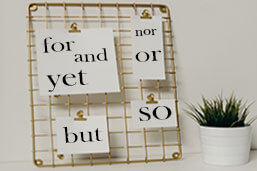
Conjunctions are parts of speech that allow you to connect two or more thoughts. There are two types of conjunctions: coordinating and subordinating conjunctions. In academic writing, coordinating conjunctions do not only connect words, phrases, or sentences, they can also stand at the start of a sentence or phrase. This article discusses coordinating conjunctions, the different rules in specific cases, and how they differentiate from conjunctive adverbs.
Definition: Coordinating conjunction
Coordinating conjunctions connect two clauses or ideas of equal grammatical and syntax importance. For instance, these conjunctions can join two verbs, nouns, adjectives, phrases, or independent clauses.
The seven coordinating conjunctions
There are seven main coordinating conjunctions in English. Each conjunction has a specific function. Therefore, memorizing all of them and how you can use them is essential in academic writing. The seven types are:
“For” is one of the most common conjunctions in English. Many people use it without recognizing what part of speech it is. This conjunction indicates that the second part of a sentence (after “for”) occurred because of the first one.
Example:
- We sat and waited, for the visitors had not arrived.
This sentence indicates that the “waiting” occurred because the visitors had not arrived.
You can also use the conjunction “for” to link a statement with a description or an explanation.
Example:
- He left early, for he was incredibly exhausted.
Note: For is also a preposition. Therefore, you should be keen about how you use it in your sentences.
Example:
- We waited for two hours.
Here, “for” is used as a preposition in this sentence.
“And” is the most common English word and one of the most used conjunctions. This conjunction helps connect two words that occur equally or with equal significance.
Example:
- We bought bananas and oranges at the store.
You can also use “and” to join two or more verbs.
Example:
- The puppies barked and chased the guests down the road.
This shows that the connected words can be verbs, nouns, adjectives, phrases, or adverbs. Additionally, you can use it to connect general ideas.
Example:
- I put the pillow behind me and fell asleep immediately.
“But” contrasts or differentiates an idea from another. However, the words or ideas are typical of equal importance.
Example:
- She was trying to listen to music, but the noise outside distracted her.
“Or” expresses an alternative in a sentence. It is one of the simplest conjunctions to use.
Example:
- You can eat a cake or a brownie at the store.
This conjunction contrasts the first idea in the sentence and the one after the conjunction. Also, you can use “yet” the same way you use “but.” However, “yet” demonstrates that the contrasting idea may occur in the future.
Example:
- I wanted to play the piano, yet I didn’t have the opportunity.
- I played for the women’s football team, yet I did not meet as many female players.
“So” indicates that one idea or action happens due to another.
Example:
- I studied hard, so I earned better grades than last semester.
However, you can also use this word as an adverb.
Example:
- I studied so hard.
“Nor” is used when combining one negative statement with another.
Example:
We did not have Pizza that day, nor the day after
Connections with coordinating conjunctions
There are coordinating conjunctions that connect two words. So, the two words need to serve the same role of expressing a central thought. In this case, the two words must be the same part of speech, like an adjective or noun.
You can also use these conjunctions to connect two phrases and create a complete thought.
Furthermore, these conjunctions can connect two independent clauses.
Finally, you can use these conjunctions to connect several items.
Starting a sentence with coordinating conjunctions
Starting a sentence with a coordinating conjunction is grammatically incorrect. This is because the sentence will appear as a fragment instead of a whole.
Coordinating conjunctions vs. conjunctive adverb
You can use conjunctive adverbs at the beginning of a sentence, followed by a comma or semicolon.
In contrast, coordinating conjunctions are used in the middle of sentences.
Printing Your Thesis With BachelorPrint
- High-quality bindings with customizable embossing
- 3D live preview to check your work before ordering
- Free express delivery
Configure your binding now!
FAQs
The seven main types of coordinating conjunctions are:
- For
- And
- Nor
- But
- Or
- Yet
- So
Students use the acronym “FANBOYS” to memorize these conjunctions.
Subordinating conjunctions connect two or more clauses of unequal rank, or one dependent on another.
On the other hand, coordinating conjunctions connect clauses or ideas of equal significance.
Basic grammar rules discourage using this type of conjunction at the beginning of a sentence. This is because you will end up with a sentence fragment instead of a complete one.
Each conjunction has its common function.
- For instance, “yet” and “but” are commonly used to compare, contrast or modify ideas.
- On the other hand, “for” is used to link a statement with a description or explanation.
